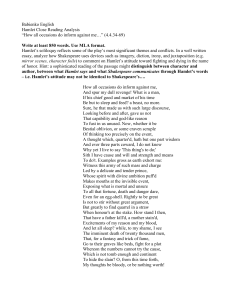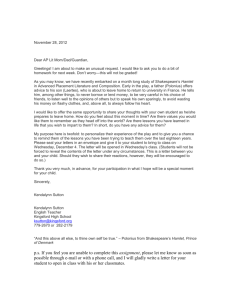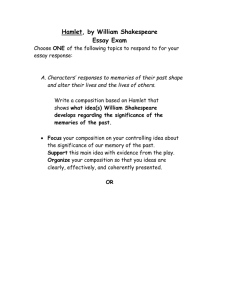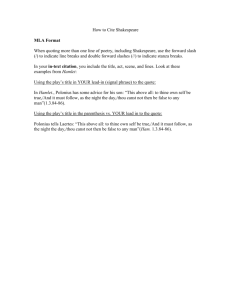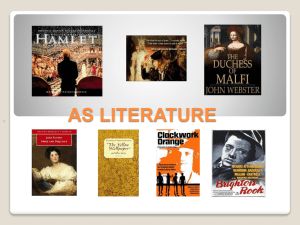Hamlet Unit Plan (shortened)_12
advertisement
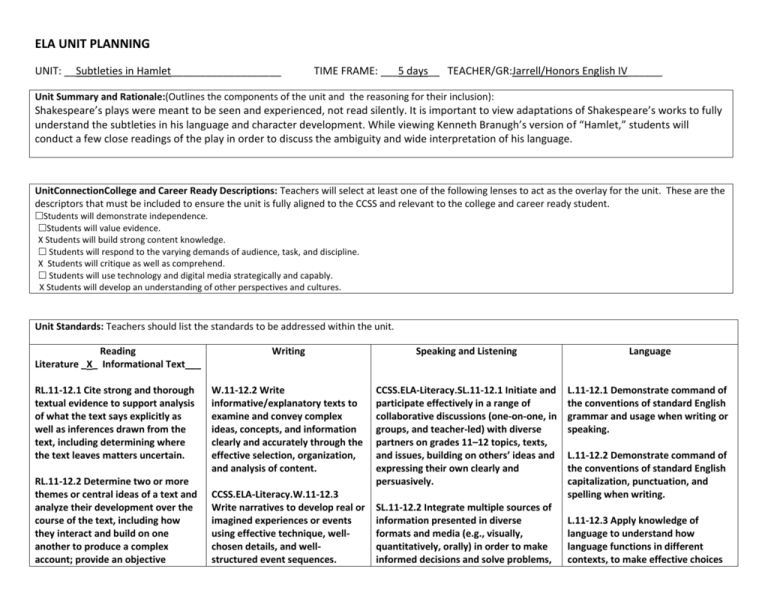
ELA UNIT PLANNING UNIT: __Subtleties in Hamlet___________________ TIME FRAME: ___5 days__ TEACHER/GR:Jarrell/Honors English IV______ Unit Summary and Rationale:(Outlines the components of the unit and the reasoning for their inclusion): Shakespeare’s plays were meant to be seen and experienced, not read silently. It is important to view adaptations of Shakespeare’s works to fully understand the subtleties in his language and character development. While viewing Kenneth Branugh’s version of “Hamlet,” students will conduct a few close readings of the play in order to discuss the ambiguity and wide interpretation of his language. UnitConnectionCollege and Career Ready Descriptions: Teachers will select at least one of the following lenses to act as the overlay for the unit. These are the descriptors that must be included to ensure the unit is fully aligned to the CCSS and relevant to the college and career ready student. Students will demonstrate independence. Students will value evidence. X Students will build strong content knowledge. Students will respond to the varying demands of audience, task, and discipline. X Students will critique as well as comprehend. Students will use technology and digital media strategically and capably. X Students will develop an understanding of other perspectives and cultures. Unit Standards: Teachers should list the standards to be addressed within the unit. Reading Literature _X_ Informational Text___ RL.11-12.1 Cite strong and thorough textual evidence to support analysis of what the text says explicitly as well as inferences drawn from the text, including determining where the text leaves matters uncertain. RL.11-12.2 Determine two or more themes or central ideas of a text and analyze their development over the course of the text, including how they interact and build on one another to produce a complex account; provide an objective Writing Speaking and Listening Language W.11-12.2 Write informative/explanatory texts to examine and convey complex ideas, concepts, and information clearly and accurately through the effective selection, organization, and analysis of content. CCSS.ELA-Literacy.SL.11-12.1 Initiate and participate effectively in a range of collaborative discussions (one-on-one, in groups, and teacher-led) with diverse partners on grades 11–12 topics, texts, and issues, building on others’ ideas and expressing their own clearly and persuasively. L.11-12.1 Demonstrate command of the conventions of standard English grammar and usage when writing or speaking. CCSS.ELA-Literacy.W.11-12.3 Write narratives to develop real or imagined experiences or events using effective technique, wellchosen details, and wellstructured event sequences. SL.11-12.2 Integrate multiple sources of information presented in diverse formats and media (e.g., visually, quantitatively, orally) in order to make informed decisions and solve problems, L.11-12.2 Demonstrate command of the conventions of standard English capitalization, punctuation, and spelling when writing. L.11-12.3 Apply knowledge of language to understand how language functions in different contexts, to make effective choices summary of the text. RL.11-12.3 Analyze the impact of the author’s choices regarding how to develop and relate elements of a story or drama (e.g., where a story is set, how the action is ordered, how the characters are introduced and developed). RL.11-12.4 Determine the meaning of words and phrases as they are used in the text, including figurative and connotative meanings; analyze the impact of specific word choices on meaning and tone, including words with multiple meanings or language that is particularly fresh, engaging, or beautiful. RL.11-12.5 Analyze how an author’s choices concerning how to structure specific parts of a text (e.g., the choice of where to begin or end a story, the choice to provide a comedic or tragic resolution) contribute to its overall structure and meaning as well as its aesthetic impact. RL.11-12.6 Analyze a case in which grasping a point of view requires distinguishing what is directly stated in a text from what is really meant. RL.11-12.7 Analyze multiple interpretations of a story, drama, or poem (e.g., recorded or live production of a play or recorded novel or poetry), evaluating how each version interprets the source CCSS.ELA-Literacy.W.11-12.4 Produce clear and coherent writing in which the development, organization, and style are appropriate to task, purpose, and audience. (Grade-specific expectations for writing types are defined in standards 1–3 above.) W.11-12.6 Use technology, including the Internet, to produce, publish, and update individual or shared writing products in response to ongoing feedback, including new arguments or information. W.11-12.7 Conduct short as well as more sustained research projects to answer a question (including a self-generated question) or solve a problem; narrow or broaden the inquiry when appropriate; synthesize multiple sources on the subject, demonstrating understanding of the subject under investigation. W.11-12.9 Draw evidence from literary or informational texts to support analysis, reflection, and research. W.11-12.10 Write routinely over extended time frames (time for research, reflection, and revision) and shorter time frames (a single sitting or a day or two) for a range of tasks, purposes evaluating the credibility and accuracy of each source and noting any discrepancies among the data. for meaning or style, and to comprehend more fully when reading or listening. SL.11-12.5 Make strategic use of digital media (e.g., textual, graphical, audio, visual, and interactive elements) in presentations to enhance understanding of findings, reasoning, and evidence and to add interest. L.11-12.4 Determine or clarify the meaning of unknown and multiplemeaning words and phrases based on grades 11–12 reading and content, choosing flexibly from a range of strategies. SL.11-12.6 Adapt speech to a variety of contexts and tasks, demonstrating a command of formal English when indicated or appropriate. L.11-12.5 Demonstrate understanding of figurative language, word relationships, and nuances in word meanings. L.11-12.6 Acquire and use accurately general academic and domainspecific words and phrases, sufficient for reading, writing, speaking, and listening at the college and career readiness level; demonstrate independence in gathering vocabulary knowledge when considering a word or phrase important to comprehension or expression. text. RL.11-12.10 By the end of grade 11, read and comprehend literature, including stories, dramas, and poems, in the grades 11–CCR text complexity band proficiently, with scaffolding as needed at the high end of the range. Essential Questions: Essential questions center around major issues, problems, concerns, interests, or themes relevant to the classroom. Essential questions should lead students to discover the big ideas. They need to go beyond who, what and where. They need to lead to the how and why. How can Shakespeare’s language be read differently depending on the emotion of the reader and the differing emphasis on specific words? How can those who watch “Hamlet” draw inferences into his inner turmoil? Big Ideas: These are what students will discover as a result of instruction and learning activities. They are the main ideas of the learning, the conclusions, or the generalizations. Big Ideas should be open-ended and apply to more than one area of study. The meaning of most lines in Shakespeare’s plays can mean different things depending on how they’re read. Much meaning is derived from the director and actor, rather than the original writer. Much of the action in the play “Hamlet” begins as an inner struggle and then begins to emerge and hurt other people. This is a subtle change that happens throughout the play. How would you change specific scenes in order to convey the best meaning possible from Shakespeare’s words? Learning Targets: What should students be able to do by the end of the lesson? Students will know the basics of the Elizabethan Period and the life of Shakespeare Students will become comfortable in reading and analyzing a Shakespearean text Students will learn the plot line of “Hamlet” Students will analyze Shakespeare’s subtle language and ambiguity of meaning Students will create their own scene using Shakepeare’s words with their own spin on them Learning Tasks: Teachers list the various tasks students will engage in throughout the unit, include use of media/other forms of information. Reading Tasks •Assimilate prior knowledge •Summarize •Infer •Analyze story/literary elements and text structures •Explain personal connections •Identify and interpret figurative language and literary devices •Analyze author’s purpose Writing Tasks •Develop a clear visual aid with use Standard English •Use text to support arguments •Write reflective responses •Compose compare/contrast responses •Edit student work (self and peers) Discussion Tasks Language/Vocabulary Tasks •Work in pairs/small groups to identify key ideas •Predict, infer, explain director choices in other versions/productions of the work Perform scene from Hamlet •Complete a running vocabulary list of unknown/confusing words •Use parallelism in writing •Employ proper capitalization and spelling •Edit student work (self and peers) Assessments: List types of assessments that will be used throughout the course of the unit. *If you do not have assessments for this unit, they should be created before moving on to the lesson design* DIAGNOSTIC FORMATIVE SUMMATIVE Journal Entry on previous knowledge PowerPoint Presentation on WebQuest Shakespeare WebQuest Watch “Hamlet” while taking active notes on the style of delivery and emphasis in language Read a few pre-selected scenes and compare them with the way they were shown in the movie Socratic Seminar on ways Branugh did well and things the class would change in the production of Hamlet Create an original scene, using Shakespeare’s script, and perform it for the class. Tickets in/out the door Text(s) Selections/Resources(generated by both teacher and student) Teachers will list the genres/titles/resources for study and indicate text complexity: The Shakespeare WebQuest can be found by going to: http://mjarrellenglish.wikispaces.com/Resources And clicking on “Shakespeare WebQuest” “Hamlet” can be found in the book room The movie “Hamlet” with Kenneth Branughcan be found on amazon.com Worksheets are available upon request

